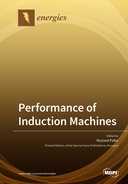Explore

Performance of Induction Machines
0 Ungluers have
Faved this Work
Login to Fave
Induction machines are one of the most important technical applications for both the industrial world and private use. Since their invention (achievements of Galileo Ferraris, Nikola Tesla, and Michal Doliwo-Dobrowolski), they have been widely used in different electrical drives and as generators, thanks to their features such as reliability, durability, low price, high efficiency, and resistance to failure. The methods for designing and using induction machines are similar to the methods used in other electric machines but have their own specificity. Many issues discussed here are based on the fundamental achievements of authors such as Nasar, Boldea, Yamamura, Tegopoulos, and Kriezis, who laid the foundations for the development of induction machines, which are still relevant today. The control algorithms are based on the achievements of Blaschke (field vector-oriented control) and Depenbrock or Takahashi (direct torque control), who created standards for the control of induction machines. Today’s induction machines must meet very stringent requirements of reliability, high efficiency, and performance. Thanks to the application of highly efficient numerical algorithms, it is possible to design induction machines faster and at a lower cost. At the same time, progress in materials science and technology enables the development of new machine topologies. The main objective of this book is to contribute to the development of induction machines in all areas of their applications.
This book is included in DOAB.
Why read this book? Have your say.
You must be logged in to comment.
Rights Information
Are you the author or publisher of this work? If so, you can claim it as yours by registering as an Unglue.it rights holder.Downloads
This work has been downloaded 76 times via unglue.it ebook links.
- 76 - pdf (CC BY) at Unglue.it.
Keywords
- accurate modelling
- artificial neural network
- Artificial Neural Networks
- automatic train operation
- dynamic model
- effective parameters
- electrical machines
- electromagnetic models
- end effect
- Energy Efficiency
- evolutionary strategy
- finite element analysis
- Finite element method
- fourth central moment
- History of engineering & technology
- homogeneity analysis
- indirect rotor field-oriented control
- induction machine
- induction machine drives
- induction machines
- induction motor
- induction motors
- LIM
- linear induction motor
- linear induction motors
- Matlab/Simulink
- mechanical unbalance
- model selection
- model-based prediction
- modelling of ring induction motors
- Monte Carlo method
- motor performance
- n/a
- one broken rotor bar
- optimization
- outer-race bearing fault
- pattern search
- rotor field-oriented angle error
- rotor winding
- simulated annealing
- slip frequency
- soft magnetic material
- solid rotor
- squirrel-cage rotor
- startup transient current
- stator winding
- Technology, engineering, agriculture
- Technology: general issues
- thermal conductivity
- thermal modeling
- three-phase induction motor
- two broken rotor bars
Links
DOI: 10.3390/books978-3-0365-4786-2Editions

